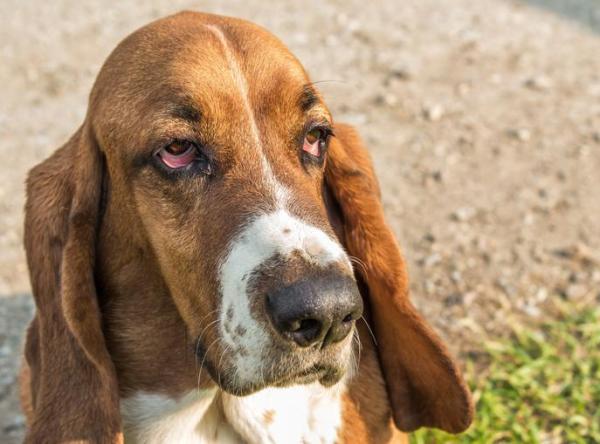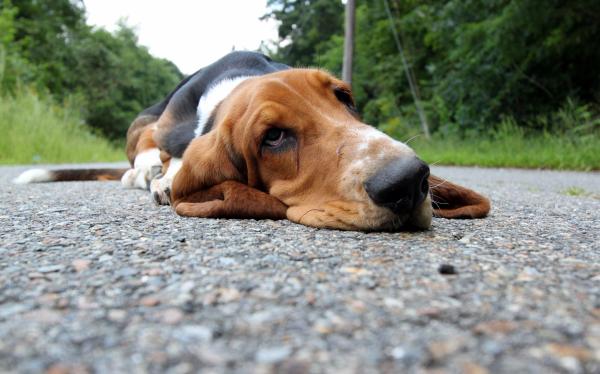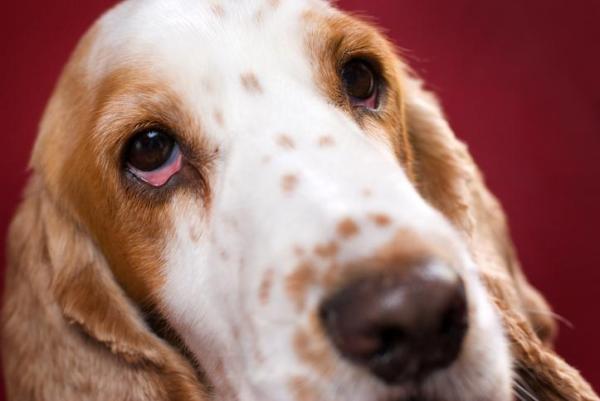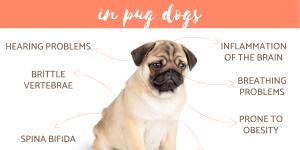Common Health Problems in Basset Hounds



See files for Dogs
Basset Hounds are a French dog breed which was originally employed for hunting, so they are capable of chasing and tracking when they want to. Families with a Basset Hound know they are their own dog. This is represented by their look which gives off an air of extreme aloofness, but looks can be deceiving. Although Basset Hounds are renowned for their stubbornness, they can also fare well under training and are generally very friendly and playful dogs. Really, they're just pretty chill when it boils down to it.
As loving and characterful companions, we want to have our Basset Hounds by our side for as long as possible. This is why AnimalWised takes a look at the most common health problems in Basset Hounds so that we can spot any symptoms early and engage the right treatment when necessary.
- Do Basset Hounds have health issues?
- Thrombopathia
- Seborrhea
- Intervertebral disc disease
- Wobbler syndrome
- Eye problems
- Elbow dysplasia
- Panosteitis
- Obesity
- Other common diseases of the Basset Hound
Do Basset Hounds have health issues?
Every dog has the potential for a health problem, especially due to environmental factors. This includes the things we cannot control, such as accidents or developing certain diseases. As guardians, our level of care will also inform how healthy a dog may be, regardless of breed.
Some dog breeds have hereditary issues which are caused by their breeding history. Breeders create dog breeds by crossing dogs of one sex with similar specimens of another. This results in a limited gene pool. If there are health problems, offspring of these dogs have a greater probability of developing them.
The Basset Hound is considered a healthy dog. They have an average life expectancy of around 10-12 years which is not low for dogs. However, they do have a propensity toward developing certain pathologies or health conditions. Many of these affect their mobility, something which may influence the fact they are considered one of the laziest dog breeds.
Different conditions are more likely to affect a Basset Hound puppy compared to an old Basset Hound. This is partly because certain hereditary conditions are more likely to show themselves when the dog is younger. As the dog ages, other conditions may be common due to the effects of time. Below, we show you some of the most common health issues in both Basset Hound puppies and older dogs.
Thrombopathia
Thrombopathies or thrombocytopathies comprise various inherited or acquired disorders affecting blood platelets and damaging their functionality. Platelets are blood cells that fulfill the function of activation, adhesion and aggregation, directly affecting the blood's ability to coagulate and heal. Diseases like thrombocytopathies interfere with these functions and prevent platelets from clumping and adhering. As a result, the body's ability to heal is impaired and becomes more prone to bleeding and hemorrhaging.
Any dog can develop a thrombocytopathy, but some dogs are more prone due to characteristics inherent in their genetic makeup. According to research carried out by the Sir James Dunn Animal Welfare Center, the Atlantic Veterinary College, the Prince Edward University of Iceland and the Canadian Veterinary Medical Association shared in the canine inherited disorders database (CIDD), one of these inherited disorders particularly affects the Basset Hound[1].
Known as ‘Basset Hound thrombopathy’, it occupies the first place on our list of health issues affecting Basset Hounds. Its main symptoms include:
- Difficulty in wound healing
- Nasal bleeding (epitaxis)
- Bleeding in mucus membranes
- Auricular hematomas (bleeding in the ears)
Seborrhea
Seborrhea (or seborrheic dermatitis in dogs) affects their skin and leads to the excessive production of sebum by the sebaceous glands. Its main symptoms are usually the formation of scabs or crusting as well as accumulation of fatty oils. Additionally, these fatty oils can produce a very pungent and unpleasant odor, especially when acute and spread across their fur. In general, the most affected regions are the face, legs and torso.
This type of dermatitis is fairly common in dogs. It often appears as a secondary symptom of another health issue such as:
- Allergies
- Nutritional deficiency
- Parasitical infestation
- Metabolic (or endocrine) problems
- Autoimmune pathologies
- Skin cancer
Some breeds show a genetic predisposition to developing so-called primary seborrhea, considered to be a hereditary disease. These breeds include the Basset Hound as well as the Cocker Spaniel, Labrador Retriever, Shar Pei, Golden Retriever, German Shepherd, West Highland White Terrier and others. It will usually develop when the dog matures from being a puppy to an older dog as hormone production increases.
Intervertebral disc disease
Due to its physical morphology, Basset Hounds are particularly susceptible to spinal problems, intervertebral disc disease (IVDD) being one of them. This occurs when the soft cartilage discs located between the vertebrae wear out and break (or herniate), generating a compression of the spinal cord.
IVDD is one of the most frequent diseases found in the Basset Hound, a well as similarly shaped breeds like the Dachshund and the Welsh Corgi, according to the CIDD. However, it can affect other dogs and cats, although less frequently. Its symptoms may vary according to the degree and location of the compression to which the spinal cord is subjected. Generally they include the following conditions:
- Intense pain and/or hypersensitivity
- Difficulty in walking
- Loss of interest in physical activity (walking, running, etc.) due to pain
- Lethargy
- Limb paralysis and inability to lift hind legs
- Urinary and fecal incontinence
Wobbler syndrome
Wobbler syndrome comprises different severe chronic degenerative disorders affecting the vertebrae and invertebral discs of the cervical spine (neck). These disorders lead to excessive compression of the spinal cord and nerves located in the neck. Although more frequent in larger dogs such as the Doberman Pinscher, it is also common in the Basset Hounds thanks the curvature of their spine.
Genetic predisposition appears as the main risk factor for Wobbler Syndrome in dogs. However, some dogs may suffer displacement of the intervertebral discs as a consequence of heavy trauma in the cervical region. It is not commonly seen in puppies. Although symptoms can develop later in life, it usually presents before the age of 3 years.
The initial symptoms are difficult to recognize in dogs as they include a headache and a stiff neck. With the advancement of the disease, more visible signs appear such a strafing or a wobble in their gait, from which the name of the condition is derived. Loss of balance is also common. If such symptoms are observed, don't hesitate to take them to the vet for evaluation.

Eye problems
There are several eye diseases which are known to affect the Basset Hound. The most common according to the CIDD are:
Glaucoma
Glaucoma in dogs is a degenerative disease which affects the eyes of our canine friends, eventually resulting in loss of vision. The clinical picture is characterized by an excessive accumulation of aqueous humor (a watery fluid in the eye) and a progressive increase in intraocular pressure. Ocular hypertension accelerates the degeneration of the retina and optic nerve, the reason why glaucoma can result in partial loss of vision or blindness.
Glaucoma in dogs can be acute or chronic. Like all degenerative processes, glaucoma has an important genetic element. It can also develop as a consequence of some underlying disease. In either case, it is a silent disease with initial non-specific symptoms which are difficult to identify in dogs.
To enable an early diagnosis of glaucoma, it is important to be aware of changes in behavior and your furry friend's appearance so you are able to recognize the first signs. These include:
- Sensitivity in the area close to the eyes
- Headache (seen in pain experienced when their head is manipulated)
- Vomiting and/or nausea
- Formation of a blueish halo round the iris
- Blurred appearance of the iris and pupil
- Irregular walking and difficulty with spatial awareness
Glaucoma in Basset Hounds most commonly develops when the dogs are older.
Ectropion and entropion in the Basset Hound
Entropion and ectropion are two different diseases which affect the eyes of dogs, specifically their eyelids. Both pathologies can be primary, i.e. they develop from a malformation of the dog which reveals an important genetic predisposition. However, secondary contraction of these diseases can also occur due to environmental conditions or as the symptom of another underlying pathology.
Entropion in dogs occurs when the edge of the eyelid is bent inward either totally or partially, being in direct contact with the eyeball. Its main symptoms are:
- Irritated eyes
- Excessive tearing
- Eye discharge which may be accompanied by blood or pus
- Eyelid visibly bent inwards
- Thickening of the skin around the eye
- Difficult opening eyes
- Blepharospasm (eyelid spasms)
- Repeated desire to scratch eyes
- Lethargy/depression
- Pain (sometimes resulting in aggressive behavior)
- Vision loss
In ectropion, the edge of the eyelid bends to the outside, exposing the palpebral conjunctiva (inner portion of the eyelid). Among its main symptoms are:
- Lower eyelid drooping and separation from the eyeball
- Redness/inflammation of the conjunctiva
- Recurrent eye irritation
- Ocular inflammation
- Recurrent ocular infections
In the Basset Hound, ectropion and entropion are associated with the morphology and standardization of the breed. Although the appearance of their ‘sad eyes’ has been incorporated as an ‘attractive’ feature of the breed (a look given to many animated characterizations such as Droopy the Dog), it is essential to be aware of the symptoms of ectropion and entropion. This is because both diseases can cause a lot of discomfort in the animal.
Cherry eye disease
Similar to ectro- and entropion, cherry eye is a result of inflammation. In this case, it is an inflammation of the tear gland. It can be seen by examining the nictating membrane, also known as the ‘third eyelid’. While it looks like it might be the result of an infection, it is actually a prolapse. It is a result of the tear gland not being anchored properly in the eye.
Cherry eye in dogs makes it look like the dog has red eyes with a small lump. This lump looks like a cherry fruit, the reason for its name. While some non-surgical treatment is possible if diagnosed in time, surgery is usually required for this condition. It is most common in Basset Hound puppies and dogs under the age of 2 years.

Elbow dysplasia
Elbow dysplasia in dogs is a degenerative disease which unilaterally or bilaterally affects the elbow joint (either on one or both sides). The result is an affected gait and issues with the dog's mobility. It originates during their developmental stage when the bone tissue undergoes an alteration and cannot develop properly.
In the first phase of the disease, the dog experiences an inflammation in the joint (arthritis) which can lead to osteoarthritis in dogs. This is a progressive wearing of the structures which make up bone and joint tissue.
Its symptoms usually appear during the first 6 months of a puppy's life, including the following signs:
- Pain
- Limping
- difficulty in walking
- Intolerance to exercise/effort
While the hereditary factor plays a role in elbow dysplasia, there are also other risk factors which can accelerate joint degeneration. The main two are obesity and inadequate physical exercise. This is why is so imperative, perhaps more so with dogs like the Basset Hound, to take care with their nutrition and amount of activity in which they engage.
Panosteitis
The self-limiting inflammatory process known as panosteitis affects the bones of the extremities of dogs. It mainly occurs during their developmental stage up to 18 months of age. Symptoms include:
- Pain when walking
- Difficulty moving
- Lameness
- Lethargy
- Weight loss
- Depression
- Aggression in response to pain
It is usually a short-lived disease, its treatment generally consisting of administering to the pain and improving the patient's living conditions. However, it is also essential to analyze the animal's state of health to rule out any possible underlying disease which may have caused the bone and joint inflammation.
Any dog can develop panosteitis, but it is most common in medium or large breeds. Genetic predisposition plays a key role (why Basset Hounds are prone to it), with obesity and lack of adequate exercise being contributing factors.
Obesity
The Basset Hound is one of the dogs which are more disposed to obesity than others which is why their diet and nutritional requirements need special attention. The amount of physical activity they receive is also paramount.
Unfortunately, many guardians believe the plump appearance of the Basset Hound is a positive trait which should be encouraged. In actuality, obesity is a progressive disease which worsens over time, resulting in very negative consequences for the dog's health. It affects older dogs in particular, but can develop at any stage of life.
This is why the dog needs to be treated quickly after initial detection of the first symptoms. Obesity is something which should be prevented from the beginning and throughout the life of the Basset Hound. Diabetes, joint problems, cardiovascular issues and many other diseases are associated with obesity.

Other common diseases of the Basset Hound
Although the aforementioned issues are the main pathologies which affect the Basset Hound breed, they are not the only ones. The following are also risk factors:
- Gastric torsion
- Third eyelid prolapse
- Kneecap dislocation
- Canine follicular dysplaisa
- Allergies
- Severe combined immunodeficiency (SCID)
- Otitis
- Dry eye syndrome
- Conjunctivitis
While these are the most common diseases and health problems in the Basset Hound, it is very important to be vigilant in maintaining the overall health of our dogs. As they cannot vocalize the state of their mental health in an intelligible manner, we need to look at the forms of communication dogs use to convey problems with their health. Mainly this involves body language and behavior.
This article is not a replacement for a vet's advice. If there is any concern over a dog's well-being, they need to be taken to a veterinarian for expert consultation.

This article is purely informative. AnimalWised does not have the authority to prescribe any veterinary treatment or create a diagnosis. We invite you to take your pet to the veterinarian if they are suffering from any condition or pain.
If you want to read similar articles to Common Health Problems in Basset Hounds, we recommend you visit our Prevention category.
1. CIDD Database. (2011). Basset Hound. Retrieved from:
https://cidd.discoveryspace.ca/breed/basset-hound.html






 My Bear, also extremely healthy right till the cancerous mass in his throat & chest, He was 13 1/2...This pic was taken for his 12th birthday...He lovd me dearly, my constant shadow & that cold wet cose constantly bumping into the back of my legs..Goofy & afraid of his own shadow but loved his (twinkies).. He's been gone just 2 mts.
My Bear, also extremely healthy right till the cancerous mass in his throat & chest, He was 13 1/2...This pic was taken for his 12th birthday...He lovd me dearly, my constant shadow & that cold wet cose constantly bumping into the back of my legs..Goofy & afraid of his own shadow but loved his (twinkies).. He's been gone just 2 mts.


 Lost my Queenie to cacer 3 yrs ago. She was 13 yrs and healthy till the cancer.
Lost my Queenie to cacer 3 yrs ago. She was 13 yrs and healthy till the cancer.



